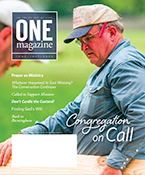
June-July 2022
Congregation on Call
------------------
|





REFRESH
Avoiding Roadblocks to Church Growth
An interview with Gordon Penfold: Co-founder of Turnaround Pastor and author of Re:Vision, the Key to Transforming Your Church; Pastor Unique—Becoming a Turnaround Leader; and Restart Churches—A Proven Strategy to Restore Vibrant Ministry in Your Church.
Ransom: What do you consider the most significant hindrances for churches and pastors/leaders from seeing growth come to their local church?
Penfold: We see three primary bottlenecks hindering church growth and turnaround:
-
Often, pastors are the bottleneck stifling church growth and vitality. Pastors must take the lead in directing revitalization efforts. Unfortunately, pastors receive little training on how to lead a church, and much less on how to lead a church through revitalization. Consequently, they often flounder in their efforts to lead church renewal.
-
A second bottleneck can be a controlling board or leadership team. We see this frequently in "stuck" churches. Controlling boards often frustrate any efforts to move a church toward revitalization. They do everything they can to maintain control over the church.
-
�The third major bottleneck is often the congregation itself. People, in general, resist change, and this is undoubtedly true in many congregations. The church body desires to maintain the status quo and will go to great lengths to do so.
Ransom: What do you believe is the first step for a church to begin to see a turnaround?
Penfold: Identify the primary bottlenecks and address them. A church can take these simple steps to initiate revitalization:
-
Train pastors in the essentials of church revitalization. We offer this training through our Turnaround Pastor Boot Camps.
-
Deal with stubborn, recalcitrant boards. This can often be a daunting task. Yet, failure to do so will mean the church will remain stagnant or declining. Board members must be removed or replaced for the church to move forward.
-
Complete a church assessment process to identify bottlenecks that create an environment of no growth.
If churches fail to address these issues, a church “funeral” will likely follow. It is imperative for churches to face the realities creating stagnation and address them.
Ransom: In your mind, what does momentum look like in a healthy church?
Penfold: Momentum occurs when churches move from one victory to the next. When individuals come to Christ. When families find restoration. When God mends broken relationships and communities experience gospel impact, the church celebrates. Momentum builds one victory upon another. Churches celebrate every victory, no matter how small, to develop a culture of winning.
Ransom: How important would you say momentum is, and how do you think a church with no momentum can get the ball rolling?
Penfold: Momentum is key! However, as I mentioned above, as the church begins to move forward, the church body must celebrate every triumph. As a church builds momentum, the hill to be climbed seems less steep and the roadblocks less daunting. Nay-sayers and doubters grow silent as the mighty power of God becomes manifest through the body. Why? People begin to see God-given possibilities, and they start to walk by faith and not by sight!
Ransom: If you had one word of advice for pastors who know their church is plateaued or declining, what would it be?
Penfold: Find a mentor, preferably a seasoned veteran, who can train and equip you to lead church revitalization. Turning around a church is one of the most daunting tasks a pastor can undertake. Find someone to guide you through the minefields you will encounter.
About the Columnist: Dr. Brad Ransom is director of church planting and chief training officer for North American Ministries. Contact Brad: brad@nafwb.org.
|
|

